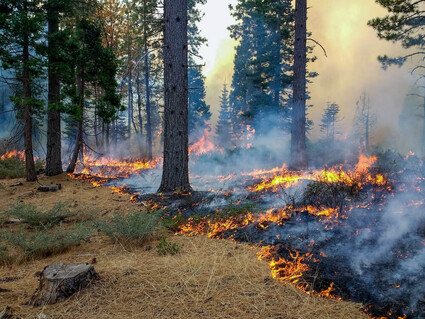Fighting fire with fire
Last updated 5/16/2023 at 3:58pm
With military-like precision, between 35 and 40 various and sundry trucks snaked their way up Pole Creek Road on Saturday. The convoy doglegged to FS 1513 in a cloud of dust on the rutted gravel road. Led by the U.S. Forest Service (USFS), the force included other agencies, like Bureau of Land Management and Oregon Department of Forestry (ODF). They massed to set fire to 112 acres.
The weather looked promising, with winds forecast to be mostly northerly at 8 mph that - if accurate - would drive smoke southbound away from Sisters. Mother Nature complied. Around 9:30 a.m. the area of prescribed (intentional) burn was ignited by skilled fire managers. It wasn't until noon that a faint amount of mostly white smoke reached Pine Meadow.
The smoke never settled in or appeared over downtown, blowing south. Sisters was full Saturday of tourists and locals taking advantage of near perfect weather. Outdoor eateries were packed, along with streets full of strollers and shoppers mostly oblivious to the high-stakes action taking place five miles away.
The managed burn was one of several in recent weeks around Sisters, with more planned. Sunday's burn - 61 acres - took place only a mile from Sisters, along FS 1605. Last Friday, 57 acres were successfully burned three miles east of Sisters, with minimal smoke affecting traffic.
There was some smoke lying in town Sunday morning due to a mild inversion.
"Prescribed fire is a critical tool that we use to reduce the risk of wildfire to our communities and to our landscape," Deschutes National Forest Public Affairs Specialist Jaimie Olle said. "We use that as a tool to get rid of the ladder fuels, that should a wildfire start in an area like this during the heat of summer, our firefighters have a much better chance of success, of being able to catch that fire and keep our community safe."
Ladder fuel is a firefighting term for live or dead vegetation that allows a fire to climb from the forest floor into the tree canopy. Common ladder fuels include tall grasses, shrubs, and tree branches, both living and dead. The removal of fuel ladders is part of defensible space practices.
The ODF smoke forecasters approve each burn as long as the conditions are right.
"They're taking into consideration everything from wind, weather, and whether there's a potential for that smoke to lift up and hopefully away from communities," Olle said. "So every single day, we're sending them our measurements of things that we're seeing on the ground, and they're determining whether it's a good day to burn."
The right conditions for a prescribed burn depend on the dryness of the area.
"Enough moisture in the fuels so the vegetation, again those ladder fuels, that carry fire up into the crown, and they want those fuels to be receptive enough to fire so that we decrease them, but keep it wet enough that we're not creating that high-intensity wildfire atmosphere," Olle said.
Among the many crews on hand for the fires, which include water tankers, fire engines, and hot shot teams in the event the fire exceeds its boundaries or intensity, were trainees with TREX.
Over 40 participants from various agencies, nonprofits, and higher education institutions from across the United States, Tribal Nations, and Canada have come to Central Oregon for a two-week prescribed fire TREX training exchange.
The training is designed for local and regional fire practitioners, scientists, and managers to work side by side as they gain experience in prescribed fire practices, fire effects, and other conservation and restoration efforts affecting forests.
Prescribed burning has long been controversial, with experts on both sides of the argument making lengthy scientific cases for their position.
A prescribed burn has a well-prepared written prescription that describes the objectives of the burn, burn unit, firebreaks, coarse and volatile fuel considerations near firebreaks, acceptable weather parameters (including wind speed, wind direction, relative humidity, temperature, and smoke dispersion), acceptable soil moisture, labor needed, equipment needed, civil authority and neighbor notifications, ignition procedures, contingency protocols, and mop-up and monitoring protocols.
Wildfires are a natural part of the forest ecosystems. The difficulty of managing wildfires, especially in locales like Sisters, led to decades of fire suppression by the USFS and other agencies during the 20th century to protect loss of life and property. Now many earth scientists profess the need for regular intentional fires both for ecosystem management and human safety.
To balance the risks and benefits of fires, federal and environmental agencies conduct prescribed or controlled burns - fires that are meticulously planned, intentionally set, and carefully managed.
Prescribed burns can mimic natural fires, while allowing land managers to determine exactly when and where an area will burn. However, controlled fires also entail some of the downsides of any fire. Burning large areas releases smoke and particulates that can damage air quality. And, no matter how well planned, is never without some risk of getting out of control.
The Sisters Ranger District has enjoyed a solid reputation for its prescribed burn program, which involves around 1,000 to 2,000 acres a year in its portion of the 1.8 million acre Deschutes National Forest.
Ideally, woodlands managers say, forests should have a 10-year prescribed burn cycle. That would mean intentionally burning 35,000 acres a year in the Sisters district, more than 15 times current rates.













Reader Comments(0)